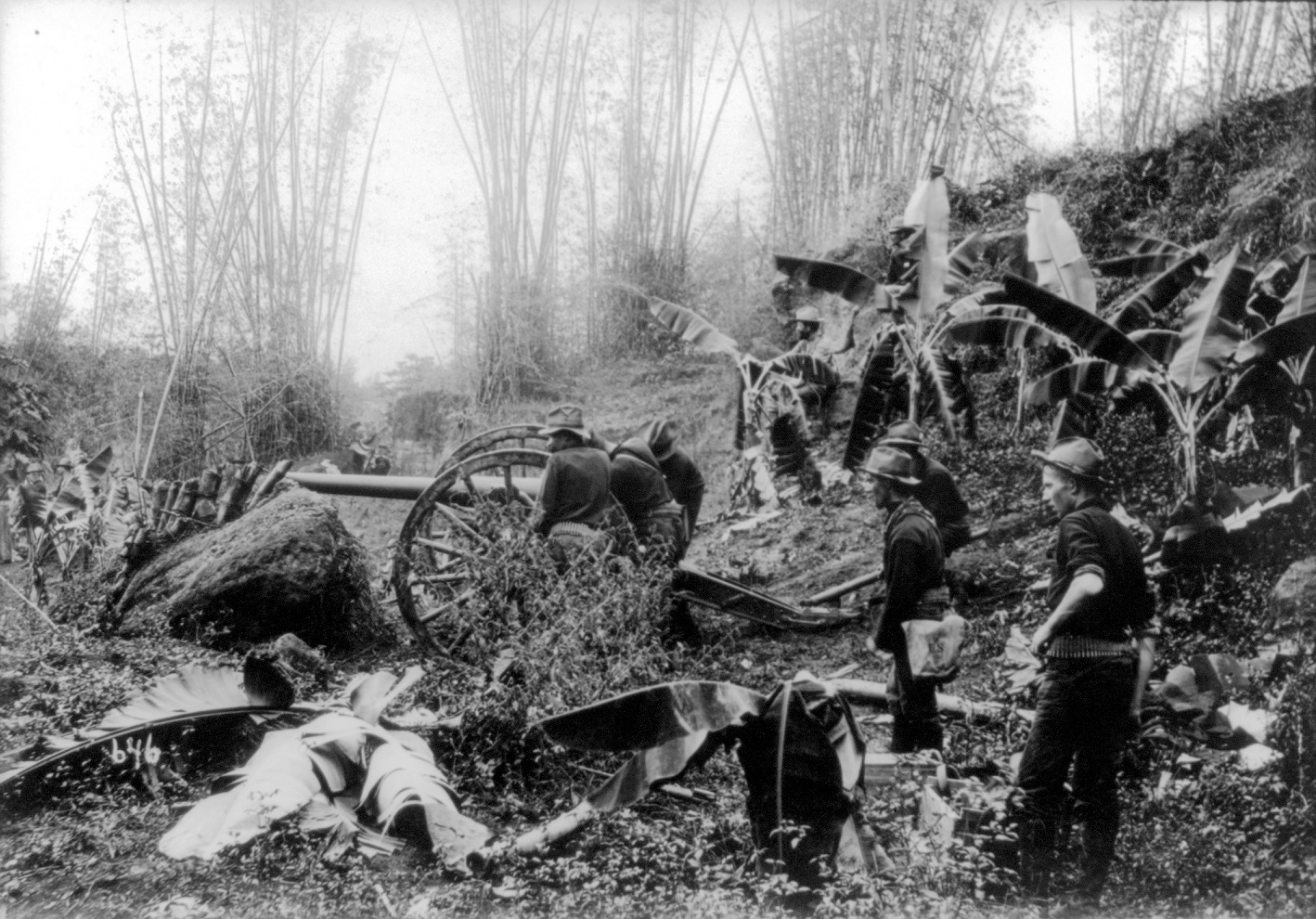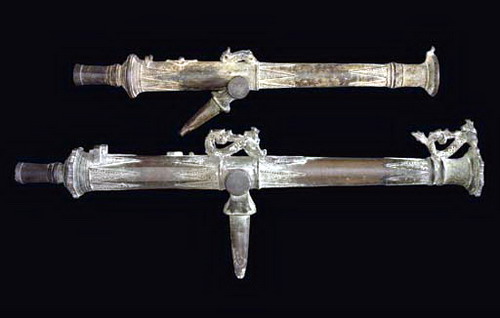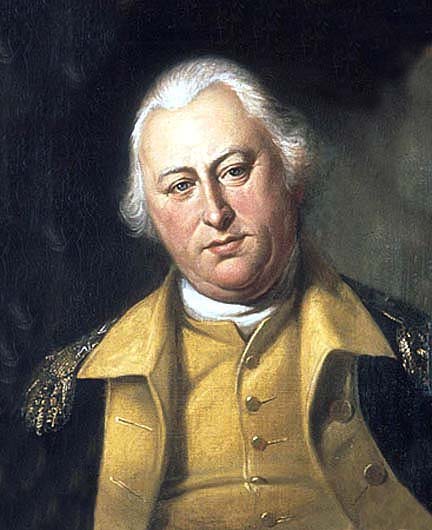|
Battle Of Siranaya
The Battle of Siranaya was a battle fought between the Philippines and the United States during the Philippine–American War. Leonard Wood led a force against Datu Ali in the Cotabato Valley in retaliation for refusing to obey an antislavery law.Arnold, J.R., 2011, The Moro War, New York: Bloomsbury Press, Wood used a force of five companies and an artillery battery with a 3.2 inch piece to attack Ali's cotta and several thousand Moros. The cotta surrendered after two days of American shelling but not before Ali and most of his men fled. The Moros left behind 21 Spanish cannons and 72 Lantakas. Secretary of War William Taft William Howard Taft (September 15, 1857March 8, 1930) was the 27th president of the United States (1909–1913) and the tenth chief justice of the United States (1921–1930), the only person to have held both offices. Taft was elected pr ... criticized Wood afterwards for the excessive use of force and brutality. References {{DEFAULTSORT: ... [...More Info...] [...Related Items...] OR: [Wikipedia] [Google] [Baidu] |
Late 19th Century Flag Of Sulu
Late may refer to: * LATE, an acronym which could stand for: ** Limbic-predominant age-related TDP-43 encephalopathy, a proposed form of dementia ** Local-authority trading enterprise, a New Zealand business law ** Local average treatment effect, a concept in econometrics Music * ''Late'' (album), a 2000 album by The 77s * Late!, a pseudonym used by Dave Grohl on his '' Pocketwatch'' album * Late (rapper), an underground rapper from Wolverhampton * "Late" (song), a song by Blue Angel * "Late", a song by Kanye West from ''Late Registration'' Other * Late (Tonga), an uninhabited volcanic island southwest of Vavau in the kingdom of Tonga * "Late" (''The Handmaid's Tale''), a television episode * LaTe, Oy Laivateollisuus Ab, a defunct shipbuilding company * Late may refer to a person who is Dead See also * * * ''Lates ''Lates'' is a genus of freshwater and euryhaline lates perches belonging to the family Latidae. The generic name is also used as a common name, lates, for m ... [...More Info...] [...Related Items...] OR: [Wikipedia] [Google] [Baidu] |
Moro People
The Moro people or Bangsamoro people are the 13 Muslim-majority ethnolinguistic Austronesian groups of Mindanao, Sulu, and Palawan, native to the region known as the Bangsamoro (lit. ''Moro nation'' or ''Moro country''). As Muslim-majority ethnic groups, they form the largest non-Christian population in the Philippines, and comprise about 5% of the country's total population, or 5 million people. Most Moros are followers of Sunni Islam of the Shafiʽi school of fiqh. The Moros were once independent under a variety of local states, including the Sultanate of Sulu, the Sultanate of Maguindanao, and the Confederation of sultanates in Lanao; withstanding repeated Spanish invasions, the Moro states remained de facto independent up until the Moro Rebellion of the early 20th century. Upon Philippine independence in 1946, the Moros continued their struggle for self-determination against a predominantly–Christian Philippines, culminating in a decades-long insurgency of armed re ... [...More Info...] [...Related Items...] OR: [Wikipedia] [Google] [Baidu] |
Datu Ali
Datu Ali, was a prominent Moro Chieftain of great distinction and the Rajahmuda of Tinukop before succeeding his cousin, Datu Uto, as Sultan of Bwayan from 1899 until 1905. He was the brother of Datu Djimbangan and Sultan Tambilawan of Kudarangan, and as a rising leader, Datu Ali overpowered his brothers to rule over Kudarangan. In 1886, Datu Ali and his cousin Datu Uto refused to honor the Spanish Flag and swore to leave no Spaniards alive in Cotabato. Some of Uto's cottas were destroyed by the Spaniards but Spanish troops failed to penetrate the Moro territory. Datu Ali attacked the town of Lepanto near the Spanish fort of Bugcaon, killing fourteen and looting the place, as the campaign ended. The fall of Datu Uto to Spanish advances in 1890 led to his exile. This created a vacuum in the Bwayan Sultanate that was filled by Datu Ali, Datu Djimbangan and Datu Piang who was a Chinese-Maguindanaw Mestizo, co-opted into the American establishment, while resistance to American Rule ... [...More Info...] [...Related Items...] OR: [Wikipedia] [Google] [Baidu] |
Leonard Wood
Leonard Wood (October 9, 1860 – August 7, 1927) was a United States Army major general, physician, and public official. He served as the Chief of Staff of the United States Army, Military Governor of Cuba, and Governor-General of the Philippines. He began his military career as an army doctor on the frontier, where he received the Medal of Honor. During the Spanish–American War, he commanded the Rough Riders, with Theodore Roosevelt as his second-in-command. Wood was bypassed for a major command in World War I, but then became a prominent Republican Party leader and a leading candidate for the 1920 presidential nomination. Born in Winchester, New Hampshire, Wood became an army surgeon after earning a Doctor of Medicine degree from Harvard Medical School. He received the Medal of Honor for his role in the Apache Wars and became the personal physician to the President of the United States. At the outbreak of the Spanish–American War, Wood and Roosevelt organized the Rou ... [...More Info...] [...Related Items...] OR: [Wikipedia] [Google] [Baidu] |
Philippines
The Philippines (; fil, Pilipinas, links=no), officially the Republic of the Philippines ( fil, Republika ng Pilipinas, links=no), * bik, Republika kan Filipinas * ceb, Republika sa Pilipinas * cbk, República de Filipinas * hil, Republika sang Filipinas * ibg, Republika nat Filipinas * ilo, Republika ti Filipinas * ivv, Republika nu Filipinas * pam, Republika ning Filipinas * krj, Republika kang Pilipinas * mdh, Republika nu Pilipinas * mrw, Republika a Pilipinas * pag, Republika na Filipinas * xsb, Republika nin Pilipinas * sgd, Republika nan Pilipinas * tgl, Republika ng Pilipinas * tsg, Republika sin Pilipinas * war, Republika han Pilipinas * yka, Republika si Pilipinas In the recognized optional languages of the Philippines: * es, República de las Filipinas * ar, جمهورية الفلبين, Jumhūriyyat al-Filibbīn is an archipelagic state, archipelagic country in Southeast Asia. It is situated in the western Pacific Ocean and consists of aro ... [...More Info...] [...Related Items...] OR: [Wikipedia] [Google] [Baidu] |
United States
The United States of America (U.S.A. or USA), commonly known as the United States (U.S. or US) or America, is a country primarily located in North America. It consists of 50 U.S. state, states, a Washington, D.C., federal district, five major unincorporated territories, nine United States Minor Outlying Islands, Minor Outlying Islands, and 326 Indian reservations. The United States is also in Compact of Free Association, free association with three Oceania, Pacific Island Sovereign state, sovereign states: the Federated States of Micronesia, the Marshall Islands, and the Palau, Republic of Palau. It is the world's List of countries and dependencies by area, third-largest country by both land and total area. It shares land borders Canada–United States border, with Canada to its north and Mexico–United States border, with Mexico to its south and has maritime borders with the Bahamas, Cuba, Russia, and other nations. With a population of over 333 million, it is the List of ... [...More Info...] [...Related Items...] OR: [Wikipedia] [Google] [Baidu] |
Philippine–American War
The Philippine–American War or Filipino–American War ( es, Guerra filipina-estadounidense, tl, Digmaang Pilipino–Amerikano), previously referred to as the Philippine Insurrection or the Tagalog Insurgency by the United States, was an armed conflict between the First Philippine Republic and the United States that started on February 4, 1899, and ended on July 2, 1902. The conflict arose in 1898 when the United States, rather than acknowledging the Philippines' declaration of independence, annexed the Philippines under the Treaty of Paris at the conclusion of the Spanish–American War. The war can be seen as a continuation of the Philippine struggle for independence that began in 1896 with the Philippine Revolution against Spanish rule. Fighting erupted between forces of the United States and those of the Philippine Republic on February 4, 1899, in what became known as the 1899 Battle of Manila. On June 2, 1899, the First Philippine Republic officially declared war ag ... [...More Info...] [...Related Items...] OR: [Wikipedia] [Google] [Baidu] |
Cotabato
Cotabato or North Cotabato ( hil, Aminhan Cotabato; ceb, Amihanang Cotabato; Maguindanaon: ''Pangutaran Kutawatu'', Jawi: ڤڠوترن كوتاواتو; fil, Hilagang Cotabato), officially the Province of Cotabato, is a landlocked province in the Philippines located in the Soccsksargen region in Mindanao. Its capital is the city of Kidapawan. Some of its barangays are under the jurisdiction of the nearby Bangsamoro Autonomous Region. History Sultanate of Maguindanao Cotabato derives its name from the Maguindanaon word ''kuta watu'' (from Malay - "Kota Batu"), meaning "stone fort", referring to the stone fort which served as the seat of Sultan Muhammad Kudarat in what is now Cotabato City (which the province derives its name from). Islam was introduced in this part of the country in the later part of the 15th century by Sharif Mohammed Kabungsuwan, an Arab-Malay Muslim warrior-missionary. Sharif Kabungsuwan invaded Malabang in 1475, facing armed resistance from the non ... [...More Info...] [...Related Items...] OR: [Wikipedia] [Google] [Baidu] |
Lantaka
The ''Lantaka'' (Baybayin: pre virama: ''ᜎᜆᜃ'': post virama: ''ᜎᜈ᜔ᜆᜃ'') also known as ''rentaka'' (In Malay) was a type of bronze portable cannon or swivel gun, sometimes mounted on merchant vessels and warships in Maritime Southeast Asia. It was commonly equipped by native seafaring vessels from the Philippines, Indonesia, Brunei, and Malaysia. Lela and rentaka are known by the Malays as ''meriam kecil'' (lit. "small cannon"), the difference is that rentaka is smaller in length and bore than a lela. and Lantakas are often called ''Kanyon'' in Filipino (literal meaning Cannon). The ''lantaka'' was cited by the National Commission for Culture and the Arts of the Philippines as an intangible cultural heritage of the country under the 'Traditional Craftsmanship' category that the government may nominate in the UNESCO Intangible Cultural Heritage Lists. The documentation of the craft was aided by ICHCAP of UNESCO. Etymology The name may stem from the Malay ... [...More Info...] [...Related Items...] OR: [Wikipedia] [Google] [Baidu] |
Secretary Of War
The secretary of war was a member of the U.S. president's Cabinet, beginning with George Washington's administration. A similar position, called either "Secretary at War" or "Secretary of War", had been appointed to serve the Congress of the Confederation under the Articles of Confederation between 1781 and 1789. Benjamin Lincoln and later Henry Knox held the position. When Washington was inaugurated as the first President under the Constitution, he appointed Knox to continue serving as Secretary of War. The secretary of war was the head of the War Department. At first, he was responsible for all military affairs, including naval affairs. In 1798, the secretary of the Navy was created by statute, and the scope of responsibility for this office was reduced to the affairs of the United States Army. From 1886 onward, the secretary of war was in the line of succession to the presidency, after the vice president of the United States, the Speaker of the House of Representativ ... [...More Info...] [...Related Items...] OR: [Wikipedia] [Google] [Baidu] |
William Taft
William Howard Taft (September 15, 1857March 8, 1930) was the 27th president of the United States (1909–1913) and the tenth chief justice of the United States (1921–1930), the only person to have held both offices. Taft was elected president in 1908, the chosen successor of Theodore Roosevelt, but was defeated for reelection in 1912 by Woodrow Wilson after Roosevelt split the Republican vote by running as a third-party candidate. In 1921, President Warren G. Harding appointed Taft to be chief justice, a position he held until a month before his death. Taft was born in Cincinnati, Ohio, in 1857. His father, Alphonso Taft, was a U.S. attorney general and secretary of war. Taft attended Yale and joined the Skull and Bones, of which his father was a founding member. After becoming a lawyer, Taft was appointed a judge while still in his twenties. He continued a rapid rise, being named solicitor general and a judge of the Sixth Circuit Court of Appeals. In 1901, President ... [...More Info...] [...Related Items...] OR: [Wikipedia] [Google] [Baidu] |
Conflicts In 1902
Conflict may refer to: Arts, entertainment, and media Films * ''Conflict'' (1921 film), an American silent film directed by Stuart Paton * ''Conflict'' (1936 film), an American boxing film starring John Wayne * ''Conflict'' (1937 film), a Swedish drama film directed by Per-Axel Branner * ''Conflict'' (1938 film), a French drama film directed by Léonide Moguy * ''Conflict'' (1945 film), an American suspense film starring Humphrey Bogart * ''Catholics: A Fable'' (1973 film), or ''The Conflict'', a film starring Martin Sheen * ''Judith'' (1966 film) or ''Conflict'', a film starring Sophia Loren * ''Samar'' (1999 film) or ''Conflict'', a 1999 Indian film by Shyam Benegal Games * ''Conflict'' (series), a 2002–2008 series of war games for the PS2, Xbox, and PC * ''Conflict'' (video game), a 1989 Nintendo Entertainment System war game * '' Conflict: Middle East Political Simulator'', a 1990 strategy computer game Literature and periodicals * ''Conflict'' (novel) ... [...More Info...] [...Related Items...] OR: [Wikipedia] [Google] [Baidu] |





